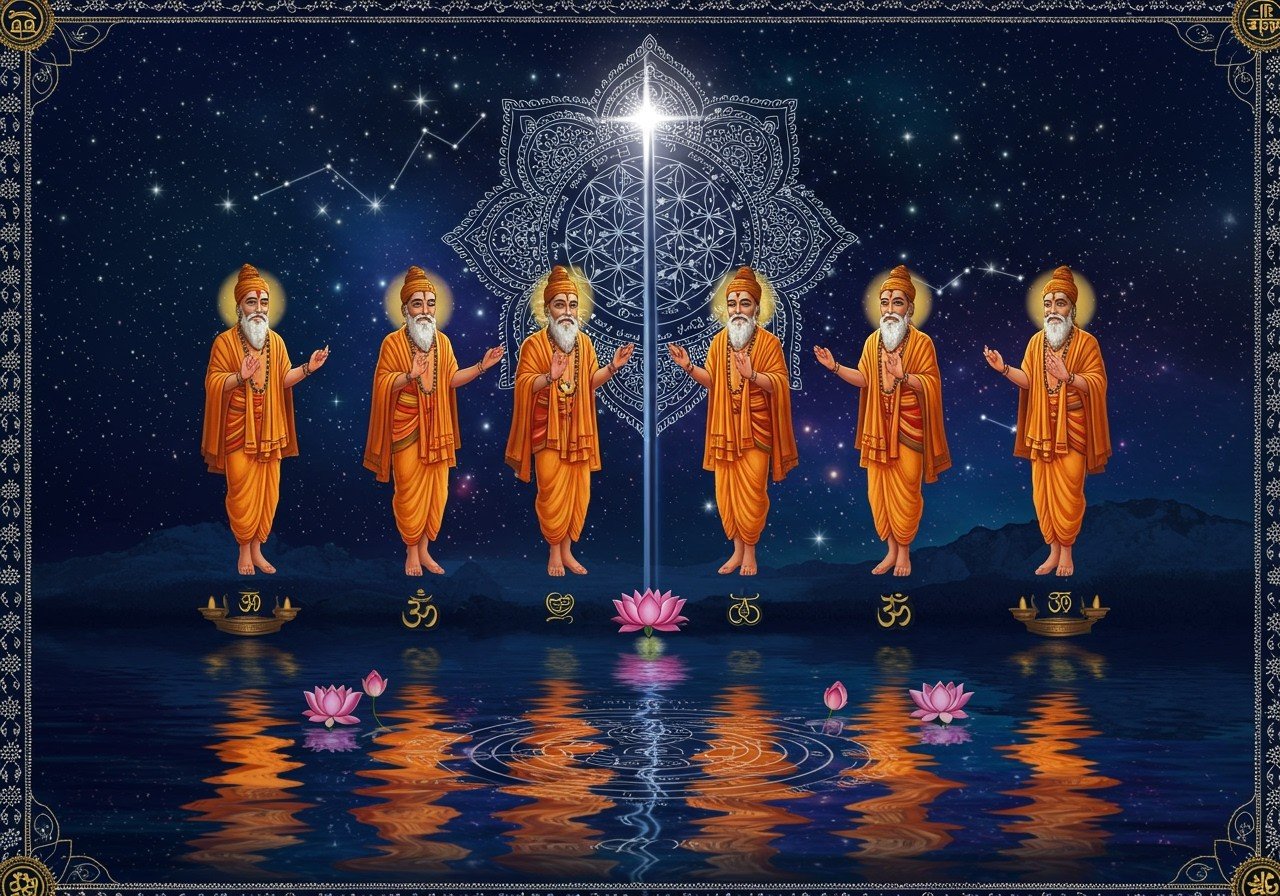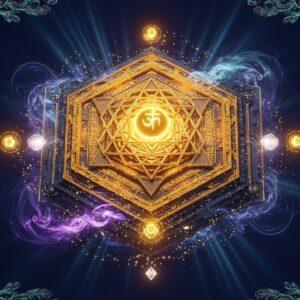
The constellation Ursa Major, widely recognized as the Great Bear or Big Dipper, holds a prominent place in the tapestry of global mythology, with roots tracing back to prehistory. In India, it is known as Saptarshi, a constellation deeply woven into Indian astronomy and mythology. It holds significant cultural and spiritual meaning, often linked with the Pole Star, guiding travelers and sailors for centuries. This article delves into its celestial location, symbolic interpretations, and the captivating mythological stories that surround it.
Saptarshi: The Seven Sages of the Night Sky
Saptarshi, signifying “Seven Sages,” is a revered constellation in Indian tradition, corresponding to Ursa Major in Western astronomy. It dominates the northern sky and remains visible year-round across much of India. Its distinct dipper or ladle shape gives rise to the name “Big Dipper.” The constellation comprises seven prominent stars, each bearing its own name and narrative within Indian lore.
Astronomical Significance
- Position: Prominently situated in the northern celestial hemisphere.
- Visibility: A year-round spectacle in most regions of India, easily discernible due to its bright stars.
- Shape: Its unique ladle or dipper shape makes it easily recognizable, aiding in celestial navigation.
These stars form a constant celestial presence, assisting in directional orientation and even providing a sense of time.
Mythological Background
Each of the seven stars embodies one of the venerated sages, or Rishis, in Hindu mythology. They symbolize wisdom, knowledge, and virtue, deeply respected within Indian culture. Understanding Saptarshi’s significance allows us to appreciate its dual role as a celestial guide and a symbol of ancient wisdom.
Saptarshi and the Pole Star: A Celestial Partnership
In Indian culture, the relationship between Saptarshi and the Pole Star, known as Dhruva Nakshatra, is especially profound. The Pole Star’s seemingly fixed position in the sky makes it a reliable navigational beacon for travelers and seafarers. Unlike other stars that appear to move, Dhruva Nakshatra remains constant, symbolizing steadfastness and dependability.
Historically, navigators in the Indian Ocean relied heavily on the Pole Star for direction, crucial for safe voyages across vast expanses of water. In rituals, the Pole Star embodies permanence and unwavering resolve, values cherished in Indian tradition.
Meaning and Symbolism
Saptarshi represents the seven revered sages, or Rishis, in Hindu mythology, each star reflecting the wisdom and virtues of these enlightened figures. The sages – Bhrigu, Atri, Angiras, Vasishtha, Pulastya, Pulaha, and Kratu – embody guidance and protection. Their stories inspire reverence for knowledge and moral fortitude.
This constellation plays a crucial role in various Indian festivals and rituals, where people seek blessings for wisdom and guidance, connecting with the sages’ enduring legacy. Saptarshi stands as a timeless emblem of wisdom and eternal knowledge.
Mythology of Saptarshi
The mythological narratives surrounding Saptarshi are rich and captivating. Tradition holds that the seven sages were mind-born sons of Brahma, the creator god. They disseminated knowledge and upheld dharma (righteousness) throughout the world. A well-known tale involves the Pandavas from the Mahabharata epic, who sought guidance from Saptarshi. Another story recounts the experiences of King Harishchandra, who learned valuable lessons through his connection to these stars. These narratives weave Saptarshi into the very fabric of Indian culture, showcasing its profound roots in folklore.
Cultural Impact and Influence
Saptarshi’s cultural influence extends far beyond mythology. Classical Indian poetry frequently references it as a symbol of eternal wisdom. Traditional Indian art forms, including paintings and sculptures, depict the constellation with reverence. In modern times, Saptarshi continues to inspire interpretations in cinema and literature, demonstrating its enduring legacy. Educators utilize it to teach astronomy and mythology to younger generations, ensuring its stories remain vibrant for years to come.
Poojn.in: Supporting Your Spiritual Journey with Saptarshi
Poojn.in, India’s leading provider of spiritual and cultural goods, offers a curated selection of authentic puja items and ritual materials to honor the celestial Saptarshi constellation. As India’s largest Dashakarma bhandar, we provide everything you need for rituals related to Saptarshi and celestial worship, including pure copper vessels, ghee lamps, and specialized puja thalis traditionally used in astronomical observations and night-time rituals. For those seeking to perform pujas during auspicious times guided by the Pole Star (Dhruva Tara), we offer complete puja samagri kits.
Our expert team ensures each product meets traditional specifications, and we offer convenient doorstep delivery across India. We also provide sacred texts and guides on the Saptarshis and their significance in Hindu astronomy and spirituality. These resources help you understand the proper methods of worship and celestial observations according to Vedic traditions.
Visit Poojn.in to discover our full range of puja items or contact our customer service team for guidance. We maintain stringent quality standards to support your spiritual practices.
Explore Brass Idols at Poojn.in
Discover Lord Kubera Murti
Conclusion: Embracing the Wisdom of Saptarshi
Saptarshi, the constellation of the Great Bear, and the guiding light of the Pole Star connect us to a realm where stars narrate tales of wisdom, guidance, and unwavering resolve. In Indian culture, it transcends a mere cluster of stars; it embodies the seven great sages whose virtues illuminate the path of righteousness and knowledge. Through mythology and tradition, Saptarshi imparts the constancy of Dhruva Nakshatra, symbolizing unwavering direction. Its stories enrich our comprehension of dharma and moral strength. Saptarshi’s presence in art, literature, and education continues to inspire, reflecting India’s deep connection to its celestial heritage. As we gaze upon the night sky, let Saptarshi inspire us to embrace its wisdom and carry forward the values of knowledge and guidance, enriching our journey with the wisdom of ages.
Frequently Asked Questions About Saptarshi
What is Saptarshi, or the Great Bear? Saptarshi, also known as the Great Bear or Ursa Major, is a prominent constellation composed of seven bright stars, easily visible in the northern sky. It forms part of the larger Ursa Major constellation and is recognizable by its distinctive dipper shape.
Where can I find Saptarshi in the sky? Look towards the north. Saptarshi is a circumpolar constellation for most northern hemisphere observers, meaning it appears to rotate around the North Star and is visible year-round.
Why is Saptarshi connected to the Pole Star? The two outermost stars in Saptarshi’s “dipper” point almost directly towards Polaris, the North Star. This alignment makes Saptarshi a useful tool for locating the Pole Star.
What does Saptarshi represent in mythology? In Hindu mythology, Saptarshi symbolizes seven revered sages (Rishis): Bhrigu, Atri, Angiras, Vasishtha, Pulastya, Pulaha, and Kratu. These sages are associated with wisdom, knowledge, and spiritual guidance.
How do I locate the Pole Star using Saptarshi? Find the two stars at the end of Saptarshi’s “dipper” (opposite the handle). Imagine a line extending from these two stars upwards; this line will point to Polaris, the North Star.
Can I see Saptarshi throughout the year? Yes, from most locations in the northern hemisphere, Saptarshi is visible year-round due to its circumpolar nature. Its position in the sky changes with the seasons, but it never sets below the horizon.
What is the cultural significance of Saptarshi in India? Saptarshi holds deep cultural and spiritual significance in India. It represents the seven sages, embodying wisdom and guidance. The constellation is referenced in ancient scriptures, plays a role in traditional rituals, and continues to be a source of inspiration in art and literature.
Learn More About Hindu Gods and Goddesses
Explore Hindu Mythology
Discover Hinduism’s Connection with Nature
Learn About Holi and Raksha Bandhan


